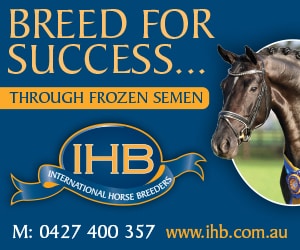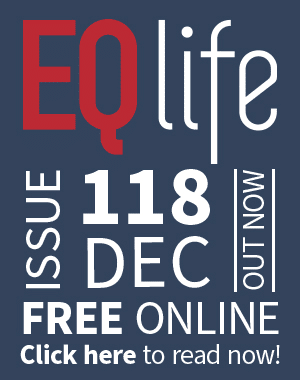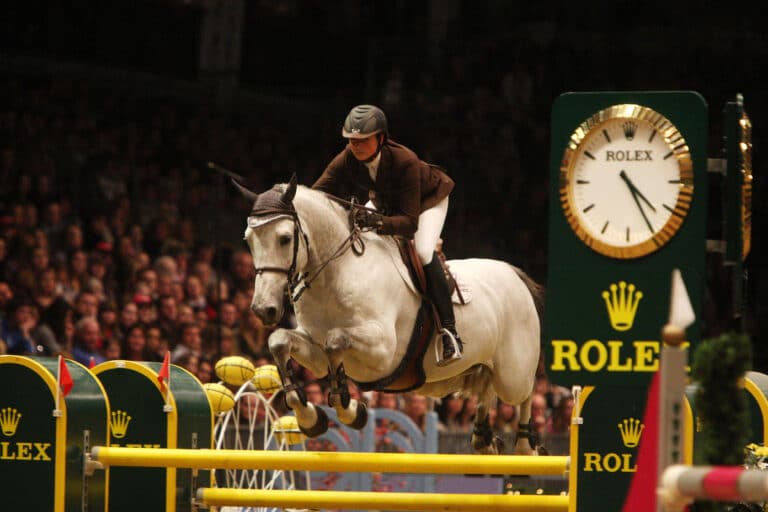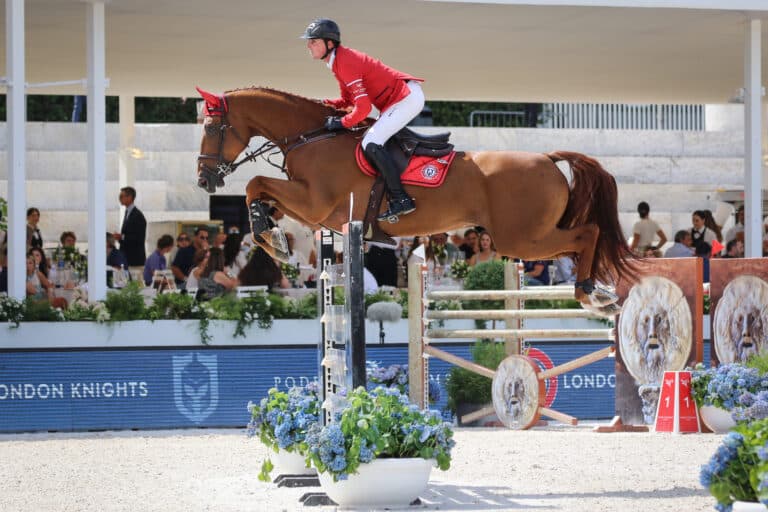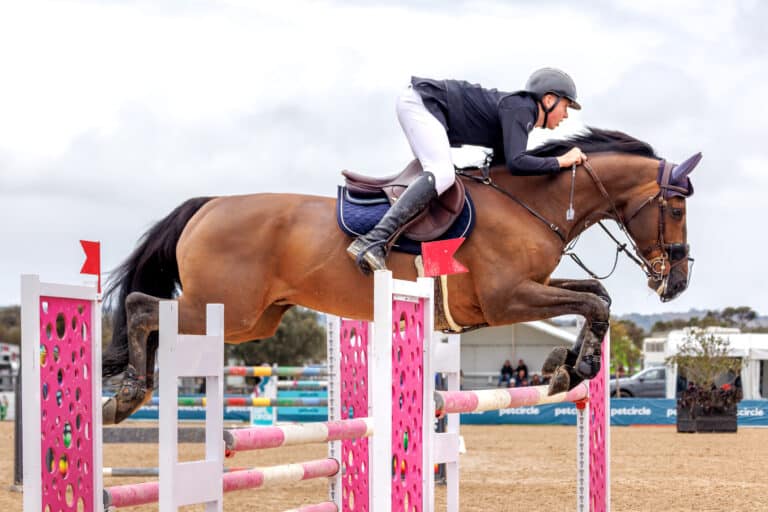This article has appeared previously with Equestrian Life. To see what is in our latest issue, please click here.

By Linda L Allen
Riding and jumping, like most other activities are best learned by doing. Practice is as essential for riders as ongoing training is for horses, no matter their current level. The old adage ‘practice makes perfect’ works best when modified to say: ‘Perfect practice makes perfect’. Written by world class course designer and retired international jumping rider Linda Allen, the schooling exercises set out have originated from years of observing the best riders and trainers in the world.
The book, forwarded by Olympic Gold Medallists David O’Connor, Joe Fargis and Bill Steinkraus, is designed for riders and instructors with exercises from the most basic through to tackling specific trouble spots encountered in training or correct particular shortcomings in a horse’s jumping technique. We have selected some of the 101 Jumping Exercises starting with a few basics.
THE ROUND FIGURE 8 OVER A SINGLE GROUND POLE

HOW DO I RIDE THIS?
1. Walk and trot over the pole, in figure 8 pattern as shown.
2. Be sure to practice the pattern in both directions and using both a larger and smaller figure 8.
HINTS Make your circles a comfortable size that allows you to maintain an even pace. Always bring your horse to the exact centre of the pole (which you have marked). Whether walking or trotting, establish a relaxed and regular rhythm well before the pole, and maintain it over the pole. Strive for very light contact with your horse’s mouth. Remember this for all these exercises! Focus on an eye level point at the end of the arena as your horse travels over the pole. Studying the pole is part of your horse’s job, not yours.
WHERE SHOULD I BE LOOKING?
One hears debate over just where a rider should focus when jumping. It is essential to focus first on the centre of the obstacle to establish your correct line of approach. Then, as you approach the obstacle on the track you have successfully established, it is equally important that you adjust your focus ahead to where you are going next. Your horse will be aware of any abrupt change in where you are looking, especially right in front of the obstacle. It takes conscious practice until it becomes automatic for you to keep your focus the appropriate distance ahead of you at all times.
CORRECT
Rider looking ahead to the next pole while horse concentrates on the one that he is going over.
INCORRECT
Rider looking down at the ground pole.
 TWO POINT POSITION
TWO POINT POSITION
Two-point position keeps you close to, but not sitting in, the saddle, even to post. Use it to find your correct balance and develop the low centre of gravity that is the mark of every effective rider over fences.
Your entire weight sinks though the ball of your foot on the stirrup and down into a lowered heel. Maintaining flexibility in all the riding joints (the hips, the knees, the ankles and the heels) is critical, as bracing or stiffening prevents achieving the balance and security that this position develops.
Pay careful attention to how you get into and out of two-point position.
FOLLOW THIS SEQUENCE:
- While riding at posting trot, quietly release your whole arm forward and place your hands on your horse’s crest approximately one-third of the way between the withers and ears, pressing down slightly.
- Be sure your leg is directly under you and your joints are relaxed, i.e. not stiff or braced. Sink your weight into your heel, and cease posting as you find your balance out of the saddle. ‘Don’t stand up’ but keep your seat out of the saddle. Be sure to keep your head and focus up.
- Feel your joints flex softly with your horse’s movement as you consciously relax your flat back and maintain a steady and secure position. As your position becomes secure, you will no longer need to rely on your hands to balance your upper body: they can become light and independent.
- To return to the posting trot, reverse the sequence: pick up your posting rhythm, distributing a part of your weight into your seat again.
- It is essential to keep your leg in position as you go from two point to posting. This prevents you from falling back into the saddle.
- To complete the return to posting trot, bring your elbows back and your hands into normal contact.
- Practice, practice, practice going into and out of the two-point position.
Your skill and ease in moving among a light seat, full seat and two-point position determine your security over jumps and your ability to assist your horse in whatever manner the job at hand requires.
THE SINGLE TROT-POLE IN TWO-POINT
SET UP Set a single trot-pole in the centre of your arena where it can be approached from both directions (the same as in the previous exercise).
HOW DO I RIDE THIS?
1. Trot the pattern shown below, maintaining a two-point position throughout the length of the straight lines.
2. Resume a posting trot around the half circles at each end of the arena.
HINTS The balance of your upper body is largely determined by the position and security of your lower leg. Be aware of even the smallest shift in your balance. If your balance tips too far ahead so you fall on your hands when your horse takes a shortened step over the pole, then your lower leg is weak and slipping back too easily or too far. If your seat falls back into the saddle when your horse takes an extended step over the pole, your seat is too heavy and your lower leg is too far forward or your knee is rigid.
BENEFITS It is well worth spending the time necessary to improve your position. The pay-off comes when you are jumping. Developing a strong and secure position is essential for both you and your horse to reach the highest levels you can achieve.
CORRECT Two-point position over trot-pole.
Developing a strong and secure position is essential for both you and your horse to reach the highest levels you can achieve.
PINCHING THE MANE
If you lack a secure leg or are riding a horse with a tendency to over-jump, master the technique of ‘pinching the mane’ so you won’t catch him in the mouth by mistake. As your horse enters the trot-pole grid, soften your arms to allow your elbows to move forward. Press your hands firmly on the top of the horse’s neck, about one-third of the distance between the withers and the ears. With one hand, pinch a substantial chunk of the horse’s mane between your thumb and the knuckle of your forefinger. Practice on the flat first, so that this becomes a smooth and relaxed move that will become automatic should something unexpected happen.
PLANNING YOUR START AND FINISH
SET UP Set a basic trot-pole grid, followed by a cross bar.
The accuracy of your aids and your horse’s willingness to listen and cooperate are critical to smooth and accomplished riding.
REMINDER Your ultimate objective is to ride effectively over entire courses of jumps. Since the departure from each jump can quickly become (or at least affect) the approach to the next one, it is vitally important to be just as effective and in control after a jump as before it. This is achieved by always having a plan and some specific goal for both horse and rider to accomplish as they land and continue on. The accuracy of your aids and your horse’s willingness to listen and cooperate are critical to smooth and accomplished riding.
HOW DO I RIDE THIS?
Planning your start is fairly straightforward. Always have your rhythm established before you begin the turn into the line of jumps. If you need to circle to achieve rhythm, do so. By this time, you should be able to establish a steady tempo within a half-circle. A planned finish must be part of even the most basic exercise. Your plan can have many variations. After riding through the gymnastic, start with simply completing a circle (called in the hunter ring your closing circle), alternating the direction each time.
Generally, you want the last jump in the grid also to be the first canter stride for your finishing circle. If you are a timid rider or riding a very green or hot horse, use the strides after the final pole or jump to complete a downward transition to a trot prior to beginning your closing circle. Otherwise, continue in the canter, finishing your circle with a smooth and progressive downward transition through the trot into the walk, if you are finished, or into the trot to continue back through your grid. If your horse lands over the pole or jump on the incorrect lead for the circle you have planned, do a simple or flying change of lead before entering your closing circle. When a single circle feels easy, add a simple change of lead followed by a second circle in the opposite direction.
Your ultimate objective is to ride effectively over entire courses of jumps.
THE START AND FINISH ARE VITAL PARTS OF EVERY EXERCISE
DOUBLE CHECK
Am I planning the next segment of the exercise while I ride? You are now learning to do just that. The secret to a cooperative horse is a rider who gives clear directions in time for the horse to prepare both mentally and physically for whatever he is being asked to do.
BENEFITS
If your horse has developed the habit of playing-up or scooting off after a jump or a line of jumps, using a range of variations on this simple exercise is the most effective way of overcoming what can be an annoying and even dangerous trait.
HOW HIGH SHOULD I JUMP?
All horses and riders benefit from training over a broad spectrum of jumps. You will come to understand your approach has far more impact on a jump’s difficulty than its height or width. Whatever height you are currently comfortable with over a complete course, you should feel confident jumping at least 6 inches or 15 cms higher and wider whenever the approach is simplified, as it is in a gymnastic line. Gymnastics set at comfortable distances are a perfect way to raise your sights and build your confidence. It is important to believe you can jump more than some arbitrary height. Today’s limits are only a reflection of the training, experience and natural talents of your horse.
A wise old horseman once said that a rider can always rise as fast as his horse can gallop: similarly, a rider can jump as high as his horse can jump. Belief in yourself, along with solid basics, are what make it possible.
Reprinted with permission from 101 Jumping Exercises for Horse and Riderby Linda L Allen. Published by Storey Publishing, available wherever quality books are sold. For wholesale enquiries contact Capricorn Link, sales@capricornlink.com.au.
READ THE LATEST NEWS ARTICLES HERE





